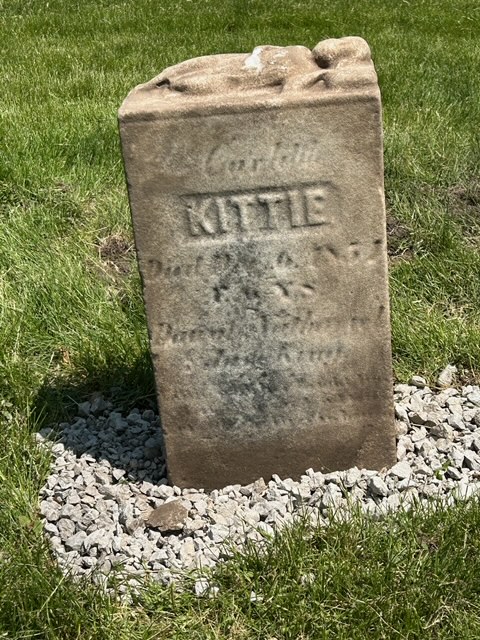Work at old Geneva cemetery uncovers headstones from city’s early history
CREDIT: By Linda Girardi, For Beacon-News
It takes some hard labor and detective work, but volunteers working at the West Side Cemetery have discovered pieces of Geneva history that have not been seen for decades.
For instance, Geneva History Museum volunteers recently uncovered an 1850s gravestone at the cemetery of a young girl named Kittie King.

The stone marker is 6 inches in width, with an epitaph reading “Our Little Kittie.”
The marker has a relief sculpture of a child sleeping. The youngster died at the age of 6 on Dec. 16, 1851. She was the daughter of Nathaniel and Jane King, according to museum officials.
“It is one of the most unusual headstones. It’s beautiful,” Geneva History Museum Executive Director Terry Emma said. “We had no idea that we would find a beautiful stone.”
Many old gravestones at the cemetery have toppled and settled over the years beneath the surface of the ground, volunteers said.
The cemetery at North Third and Stevens streets is where some of Geneva’s earliest settlers are buried.
“These are some of our founding families who have had experiences and life in Geneva,” Emma said.
The museum wants future generations to be able to see the burial sites and learn about those buried at the historic cemetery, she said.
“We research who they are and what they did during their time here. It brings respect and dignity to the families,” Emma said.
The museum began the West Side Cemetery restoration project in 2019. To date, more than 200 headstones have been cleaned and restored, officials said.
A group of volunteers worked on some 20 headstones dating to the 1850s and 1860s on a recent Saturday. Each headstone was documented for the type of stone used, its size, condition and more.
The group was instructed to work in a designated area at the cemetery by Geneva History Museum Educator Heidi Howlett.
“I do cemetery walks and noticed that so many stones were underground,” Howlett said.
Howlett received training through the Illinois Department of Natural Resources on how to clean, restore and repair headstones.
The museum relies on historical records to locate the gravesites at the cemetery. There are no permanent records of burials there before 1914, she said.
Volunteers would probe a grassy area and once they felt a tap from a stone surface they used shovels to uncover a missing headstone. Some of the grave markers weigh hundreds of pounds, officials said.
Several of the headstones discovered were reassembled because they were cracked in two pieces, while others required only some work using a water solution to wash away decades of dirt and debris.
Some of the hidden headstones are found in pristine condition, officials said.
The group uncovered a headstone of Lucy, wife of A.G. Bentley.
“It’s an expensive stone with all of the different fonts. It was found in pristine condition,” Howlett said.
Lucy Bentley died in 1859 at age 35. The couple’s infant son died a year earlier and is buried beside them.
“The cholera outbreak hit in the mid-1850s. There are a lot of burial sites from around that time,” Howlett said.
The Geneva History Museum supports the restoration project by offering its historical records and working with volunteers interested in learning more about the cemetery, Emma said.
Markus Olesen and Chuck Howlett were among the volunteers recently that located some old headstones barely visible on the ground’s surface.
“It’s a way to give back to the community,” Olesen said.
Steven Dexheimer, of Geneva, said the volunteers enjoy the historical exploration of locating the gravestones.
“It’s about as close you can get to being an archaeologist without an archaeological degree. You are probing in the ground and realize there is an entire stone there,” Dexheimer said.
———-
Linda Girardi is a freelance reporter for The Beacon-News.
